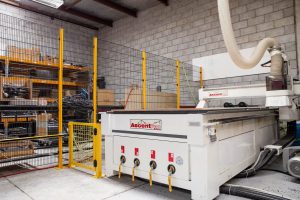City growth plans leave NZ’s manufacturing sectors in the cold
Hutt Valley Chamber of Commerce calls for better consideration of commercial and industrial growth as part of city regional spatial planning in the next 30 years.
The Hutt Valley is one of the largest manufacturing and technology engine rooms in New Zealand. The region has earned its name as ‘Technology Valley’ for being a hi-tech, innovative, and creative thinking hub.
Boasting over four times the number of scientists, researchers, and technologists, per capita, when compared to the rest of New Zealand, the Hutt Valley is an incubator for innovative hi tech start-ups and advanced manufacturing.
With a strong research and development community, motivated venture capital companies, a network of support agencies, including the Hutt Valley Chamber of Commerce, Crown Research Institutes and the city councils, the region has become a desirable place to run a business, particularly for owner-operators in the manufacturing and technology sector.
As many cities and regions throughout the country experience rapid growth, it is imperative the manufacturing and technology sector is seriously considered when spatial planning for the future.
Helen Down, Chief Executive of the Hutt Valley Chamber of Commerce said smart forward thinking spatial planning supports economic growth.
“For example, one of the biggest challenges facing the region is a scarcity of quality commercial and industrial buildings with good earthquake ratings, as well as Greenfield and Brownfield sites which enable businesses to build to specific requirements.”
High-tech company, Times7, specialises in the design and manufacture of specialised radio frequency identification antennas, known as RAIN (UHF) RFID.
From their base in Alicetown, Lower Hutt, Times7 exports all over the world. It is a well-established brand in the global radio frequency identification market.
The company recently consolidated their manufacturing back onshore in their Lower Hutt facility after also manufacturing in the United States over the last four years. Founder, Jos Kunnen, said they are committed to sustainable manufacturing and the Hutt Valley.
 “With our increased local capacity and capability, our ongoing product development and process improvements, it made sense to bring this in house. One of our organisational design principles is that we operate our complete team in one location from marketing and sales to engineering and production,” Jos Kunnen said.
“With our increased local capacity and capability, our ongoing product development and process improvements, it made sense to bring this in house. One of our organisational design principles is that we operate our complete team in one location from marketing and sales to engineering and production,” Jos Kunnen said.
Along with other local manufacturers, the company is experiencing huge growth, and has recently hired several young people to join their team in a variety of roles. This is good news, however, with that growth came challenges.
“We have been looking for over a year for suitable premises to expand into, in reasonably close proximity to where we are located now. We need good offices and amenities, as well as a reasonably large warehouse, workshop areas, and engineering lab space,” Jos Kunnen said.
Several buildings that seemed suitable had very low earthquake New Building Standard ratings and because of high demand lease costs seem to be rising even faster than residential rents.
The Hutt Valley Chamber of Commerce is concerned that the lack of good quality commercial and industrial buildings and development sites in the region long term will impact on attracting and retaining modern manufacturing and technology businesses.
Chief Executive, Helen Down, is calling for all local and regional government agencies to proactively better incorporate commercial and industrial space as part of city spatial planning to support growth and development into the future.
“I’m hearing from businesses nearly every week who can’t find space to expand into. We have had such rapid growth in the Hutt Valley, yet there is a lack of suitable commercial space to support the growth.
In many long term spatial plans for future city and regional development there is nowhere enough consideration for new commercial and industrial spaces.
While some reports will show there is capacity in current business areas, the composition of those areas reflect outdated business models and are not suitable for today’s manufacturing and technology business requirements,” she said.
The Hutt Valley Chamber of Commerce wants councils to think more creatively and broadly about city development, if manufacturing and technology companies are to grow and thrive and contribute to economic development.
Jos Kunnen agrees and said councils need to make provisions in the long-term plans for space and areas for the development of appropriate industrial and commercial properties.
“As hi-tech start-up manufacturing businesses grow, they need better space to accommodate their engineering and software development teams, as well as their production facilities. To entice and retain good staff, there is a need for sound, safe, modern working spaces, with the types of facilities one would usually see in a modern office block,” Jos Kunnen said.
Times7 production is expected to double this year but the hurdle of finding larger premises to support the projected business growth is proving problematic to growth plans.
Helen Down champions the Hutt Valley as an ideal location for manufacturing businesses and would like to see much more consideration and provision in the spatial planning to support this as well.
“And it is not just a challenge in the Hutt Valley and Wellington Region. Country -wide there has been a lot of noise around residential housing and protecting horticulture land from urban sprawl, but no noise around prioritising good industrial land,” she said.
“If we don’t consider new industrial and commercial land in spatial planning it will be disastrous long term. If we don’t plan smarter in our cities, and our regions then businesses will move elsewhere. As we all work hard to rebuild our economy and take advantage of the opportunities, failure to ensure we have suitable areas for commercial and industrial growth will seriously harm our long term employment and economic growth.”
The Hutt Valley Chamber of Commerce is calling on government at all levels to consider how commercial space is being allocated as part of future spatial planning in the regions and cities.
With closed borders and supply chain issues, more manufacturing and IT businesses are looking at how they can operate solely from home bases in New Zealand, and with New Zealand based supply chains.
If spatial planning is all about how we will grow and thrive, then commercial property has to be part of that landscape to ensure our communities, employment and economic development are future proofed.



